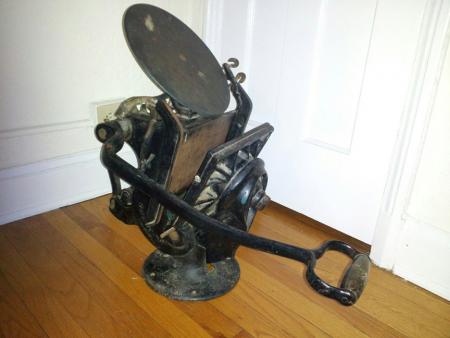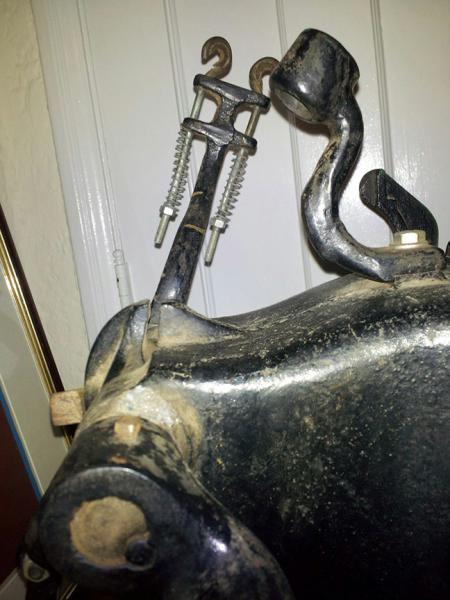Golding Official No. 2(a) ?
Being relatively new to letter press, but have had the urge to find a tabletop model I recently acquired what I’m understanding to be a Golding Official (name is cast into base) No. 2(a)? The issue with it is that 1 of the roller bracket - arms (for lack of a better term, as I cannot locate the correct name) has been broken off at one time and poorly repaired and re-broke. I am hoping to take this to a local welder for repair (or to be told otherwise) and if this is the case, is this an easy piece to find as a replacement..and if so, what is the correct name? Any insight would be greatly appreciated as I am also needing a chase and rollers.

Golding1.jpg

Golding1c.jpg

Golding1d.jpg
Hi,
You have a number of issues. I may be able to help. I don’t remember what I have left for this model. I will check my parts tomorrow and get back with you. The name of the part per Golding is “ink frame”. This is a very early example of a No. 4 and I may need some additional photos to determine your needs. I can tell you from what you posted that your roller hooks are not correct and need to be replaced as well. Rollers and trucks are available from Ramco Roller products and others but you will need to replace the improper parts first for the new trucks and rollers to fit as they are made to Golding specs.
John
John,
Thanks for your reply. I have done some digging on BP and online in the hopes to educate myself but have probably ended up only to confusing myself more in the process. I hope to post more photos and figure out a year, but was not able to find any serial number stamping as of yet.
Paul
Additional photos taken. Looking forward to getting the repair addressed.
2013-10-22 17.59.23.jpg
2013-10-22 18.01.55.jpg
2013-10-22 17.58.23.jpg
2013-10-22 17.58.09.jpg
2013-10-22 17.57.22.jpg
2013-10-22 18.01.24.jpg
Would anyone have a lead on where I could obtain additional information, specs, where, / who can provide rollers (no cores), original roller springs - hooks, etc? The only information I have been able to find is on the later models, so I assume there were changes / upgrades after this model?
I dropped the press off to get the ink frame arm repaired (hopefully) and had not found a serial no.
I think these are original hooks and springs, hooks look hand hammered flat on the ends you can see the ones next to it.
I have original set of rollers, rubber from the 1970s and all new copys. I have a hook bender to look me up. I would like to see it come back to life.
sigwalt 019.jpg
Ink frame arm repaired, aligned this last week..Looks a lot better than what was previously. Thou, the next issue seems to be that the arm which is to advance the ink plate does not engage teeth (about an inch shy). Is there an adjustment which is incorrect? or is this the wrong ink plate? I have seen this image of teeth cut and running along the perimeter of the disc. Is this what I should have?
Screen Shot 2013-11-11 at 3.35.48 PM.jpg
2013-11-11 10.48.06.jpg
2013-11-09 15.34.05.jpg
2013-11-09 15.33.49.jpg
Sorry for beating the dead horse.
Would there be any reason as to why the ink disk arm and ink disk pawl arm would be bolted as opposed to a solid casting as in every other model I have seen? Could this be a repair from being broken off and spliced together? Could this be the reasoning that the ink pawl does not contact with the disk teeth (cut, shortened, spliced)?
Hi Paul,
Me again. There is a reason. It is older than what you are comparing it to and likely was always bolted. The lug that is part of the main casting that the ink disk support is bolted to is square. It would be round if it had originally been cast as part of the body. The pawl arms of older presses like the Pearl are also bolted, so, I think it makes sense that an early Official started out with these items bolted, rather than cast as one part. This doesn’t mean that the relationship between these two parts is correct, just that they likely were always bolted.
John
Paul, Sir one little observation after a study of your your direct on side view, (love the parque flooring) the shot appears to be virtually level from a photographic aspect, and Appears to show the swan neck ink disc support top face, at exactly the same level as the roller bearers final approach to the disc, surely with the ink disc sitting in and on the swan neck at even say 1 to 1 1/4 inch, extra thickness, the finger will be out of reach by this amount ??? Foreign part from another machine maybe, and the securing bolt looks suspiciously like a modern bodge, with Metric bolt, imperial bolts generally had no legends/info on the crown, (as pictured)
By implication, previous unsuccessful repair?? good luck..
Pure coincidence which happens occasionaly, re this batch of post,s including my previous, and others in the same chronological time frame herein, appertaining to GOLDING No 2 *Mike 67 Printer* 18th November, Good shot of said Golding No 2 with Ink Disc support cast as part of the main frame??
Later modification, or evidence of dud repair??
John,
Thanks. I took another look at the casting ends when I got home and where they mate up and your point is accurate. They are chamfered and wouldn’t make much sense as a repair if broken off. Considering the poorly repaired ink frame arm. Just a case of me looking for any reasoning…and one that probably doesn’t exist aside from what the obvious may be. ;)
Also find it odd that these parts were separately bolt, opposed to originally cast. In my head it would seem that they would cast and then figure out to make them replaceable when earlier presses got these parts broken. Funny, again…thinking too hard.
Hi Mick,
A couple of things.(I think to be true) His press is a No. 4, not a No. 2, but, that is not the important part of my response. The ink disk support is roughly level with the rails, but, it looks to be angled down so the leading edge of the ink disk falls below the rails as it should. Yes, the bolt is new, and has been replaced, but, look more closely. The support has a ridge designed to help hold the support straight. And, the casting lug it is bolted to is square, not round as it would be if cast into the body as in newer style. This exact same type of attachment occurs on the Pearl ink pawl arm that preceded this model. The picture you are comparing it to is a newer press. Other differences exhibited are that the gripper drive mechanism is on the opposite side from the newer style press. Most importantly, I have seen this square lug before on another very early Official press that was a hand inker that had no ink disk at all. The square lug was very evident. I don’t think I have a picture to attach to illustrate unfortunately Interestingly, Golding went to bolt on ink disk supports very late int the production run, but, they were mounted with two bolts and via a larger mounting plate. With all this in mind, I am pretty confident this was originally bolted. What I don’t know is why the pawl does not come into contact with the disk, but, I still question if the repair to the ink mechanism arm that the pawl arm is attached to is the cause. I wonder if the ink pawl continued on its arc past where it can currently go after the handle is pulled all the way, if it would contact the ink disk. If it does, that would be very telling.
Paul,
I don’t blame you a bit for looking at anything to figure this out. There has to be an answer that is discover-able. You’re not thinking too hard! As stated above to Mick, Golding did go to a bolt on support for the ink disk very late in the production run in the 1920’s Not for the ink pawl arm however. That is only evident in Pearl presses that predate yours.
John
John, Sir thank you for deciphering my ramblings, I appreciate that they are frequently just that, humble ramblings, based more on, (hopefully) appreciation of long involvement with print machinery and just occasionally seeing a problem from a different angle.
With only small shots, on line, and from considerable distance, (U.K.) at a disadvantage, for advice/reccomendations.
But just possibly my overview from an unbiased standpoint, may trigger a new line of thought and help to answer the question(s)
Even if the *Old Goats* ramblings attract a few more views. Just to see the latest offerings, e.g. Mine, the discussion is prolonged and possibly, solutions arrive faster and more comprehensively???
**Too much Mono-Tripe rubbish and not enough of much else** but gotta try, before the Grim Reaper gets me??
Thanks Apologies and Regards Mick.
Mick, John
I appreciate all your insight and help in providing any information as it is all very helpful. Being located in Indianapolis there isn’t a very large knowledge-base of early letterpress. I will touch base with the fellow who repaired the ink frame arm soon to see what may transpire. Unfortunately this will need to be after Thanksgiving and our office move.
I hope to have more information to report shortly.
I’m just trying to visualize the movement of the machine here, but when you pull the lever up, the platen opens until it’s bottom stop contacts the base, the rollers are brought down and the ink disk pawl is brought forward to engage the ink disk, yes? When the lever is as far up as it can go, how far down the rails are the rollers and how far open is the platen? As a related question, how far down does the lever travel before the mechanism hits it’s stop on the back of the frame? Could the lever have been removed at some point in the past and put back on in the wrong position? If it was, the mechanism might not be reaching fully open position and therefore not letting the pawl contact the ink disk. I hope that made sense.
—
Michael Hurley
Titivilus Press
Memphis, TN